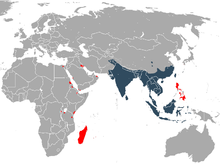House shrew
| Asian house shrew | |
|---|---|
 |
|
| Scientific classification | |
| Kingdom: | Animalia |
| Phylum: | Chordata |
| Class: | Mammalia |
| Order: | Eulipotyphla |
| Family: | Soricidae |
| Genus: | Suncus |
| Species: | S. murinus |
| Binomial name | |
|
Suncus murinus (Linnaeus, 1766) |
|
 |
|
| Asian house shrew range (blue — native, red — introduced) |
|
The Asian house shrew (Suncus murinus) grey musk shrew, Asian musk shrew, money shrew, or simply house shrew is a widespread, adaptable species of shrew found mainly in South Asia but introduced widely throughout Asia and eastern Africa.
It is a large shrew with a strong musk smell. It is related to the Etruscan shrew.
This species is locally called chuchunder in India and is mentioned in Rudyard Kipling's Jungle Book, as a nocturnal inhabitant of houses in India, by the name of chuchundra. However, Kipling's mistaken use of the name 'musk rat' has led to confusion with the unrelated North American muskrat (Ondatra zibethicus), and the latter species, not found in India, was (erroneously) illustrated in the Jungle Book.
This house shrew is categorized as a species of Least Concern on the IUCN Red List. It is also considered an invasive species and implicated in the demise of several island lizard species.
Suncus murinus has a wide distribution throughout the Old World Tropics. In most of its range, it was introduced by man. According to Burton and Burton, it was originally native to the forests of India. It has been introduced by man to Sri Lanka, eastern Africa, Madagascar, islands in the Indian Ocean (Reunion, Comoros), Pacific Ocean (Guam, etc.), South-east Asia, China, southern Japan, Malaysia (Peninsular Malaysia, Sabah, Sarawak), Kalimantan, Brunei, Indonesia, New Guinea, and throughout Iran and Arabia to Egypt and Pakistan also.
The house shrew has a uniform, short, dense fur of mid-grey to brownish-grey color. The tail is thick at the base and a bit narrower at the tip, and is covered with a few long, bristle-like hairs that are thinly scattered. They have short legs with five clawed toes. They have small external ears and an elongated snout. They also emit a strong odor of musk, derived from musk glands that are sometimes visible on each side of the body. The odor is especially noticeable during the breeding season.
Like all shrews, the Asian house shrew is plantigrade and long-nosed. The teeth are a series of sharp points to poke holes in insect exoskeletons. It is the largest of the shrew species, weighing between 50 and 100 g and being about 15 cm long from snout to tip of the tail.
...
Wikipedia

